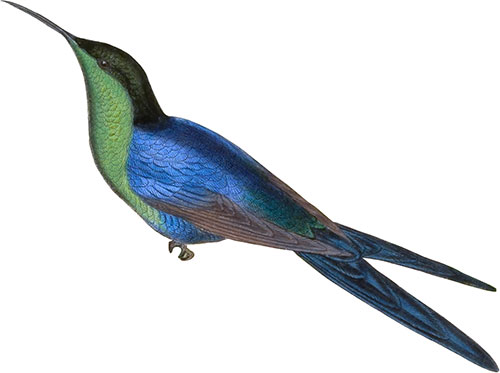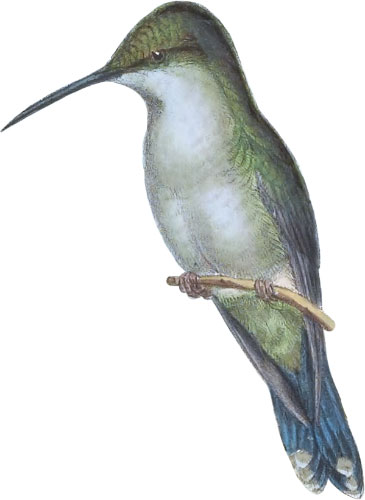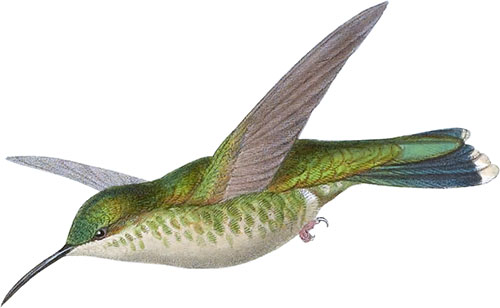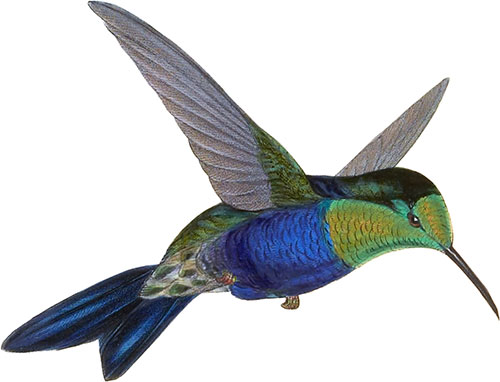Veraguan Wood-Nymph
Chiriqui in Costa Rica
The discovery of this new species by the celebrated traveller Warszewicz near the volcano of Chiriqui in Veragua is of twofold interest; first, as adding an additional species to the well-defined genus Thalurania, and, secondly, as affording still further evidence that most of the forms at one time considered to be peculiar to the continent of South America proper, have their representatives in the countries lying to the northward at the Isthmus of Panama, generally known as Central America.
Besides the specimens procured by M. Warszewicz, I have received others from the same district through M. Verreaux; these latter, although sufficiently perfect for the purpose of figuring, were not in very good condition. M. Warszewicz describes the living bird to be an object of the greatest beauty, and one can readily believe the truth of his assertion, as, unlike every other member of the genus, not only is the crown, but the greater part of the back of the neck, the entire mantle and the shoulders are clothed in a rich livery of purplish blue; in size it is about the same as T. furcata, but its rich bluish-black tail is still more deeply forked. No one member of the genus is more scarce in our collections than the T. venusta; it is to be hoped therefore that explorers will at no distant date procure us a further supply of this lovely species.
By some accident the name of puella, which I originally intended to apply to this species, but for which I substituted that of venusta, has found its way into Dr. Reichenbach’s and other lists of the Trochilidæ, which I regret, as it tends to produce confusion; I therefore take this opportunity of saying that the two names are synonymous, and that the one here retained—venusta—is the one to be adopted.
The entire crown, back of the neck and upper part of the back, shoulders, abdomen and under tailcoverts beautiful shining ultramarine blue; throat and fore part of the neck rich metallic green; wings purplish black; tail blackish blue; bill black.
The figures are of the natural size. The plant is the Odontoglossum hastilabrum.
 Thalurania glaucopis
Brazilian Wood Nymph
Thalurania glaucopis
Brazilian Wood Nymph
 Thalurania Watertoni
Waterton’s Wood Nymph
Thalurania Watertoni
Waterton’s Wood Nymph
 Thalurania furcata
Cayenne Wood-Nymph
Thalurania furcata
Cayenne Wood-Nymph
 Thalurania refulgens
Refulgent Wood-Nymph
Thalurania refulgens
Refulgent Wood-Nymph
 Thalurania Tschudii
Tschudi’s Wood-Nymph
Thalurania Tschudii
Tschudi’s Wood-Nymph
 Thalurania nigrofasciata
Black-banded Wood-Nymph
Thalurania nigrofasciata
Black-banded Wood-Nymph
 Thalurania Columbica
Columbian Wood-Nymph
Thalurania Columbica
Columbian Wood-Nymph
 Thalurania verticeps
Green-crowned Wood-Nymph
Thalurania verticeps
Green-crowned Wood-Nymph
 Thalurania Eriphyle
Brazilian Wood-Nymph
Thalurania Eriphyle
Brazilian Wood-Nymph
 Thalurania? Wagleri
Wagler’s Wood-Nymph
Thalurania? Wagleri
Wagler’s Wood-Nymph
 Thalurania hypochlora
Citado Wood-Nymph
Thalurania hypochlora
Citado Wood-Nymph
 Thalurania jelskii
Jelski’s Wood-Nymph
Thalurania jelskii
Jelski’s Wood-Nymph
 Thalurania furcatoides
Para Wood-Nymph
Thalurania furcatoides
Para Wood-Nymph
Featuring all 422 illustrated species from John Gould’s A Monograph of the Trochilidæ, or Family of Humming-Birds arranged by color.